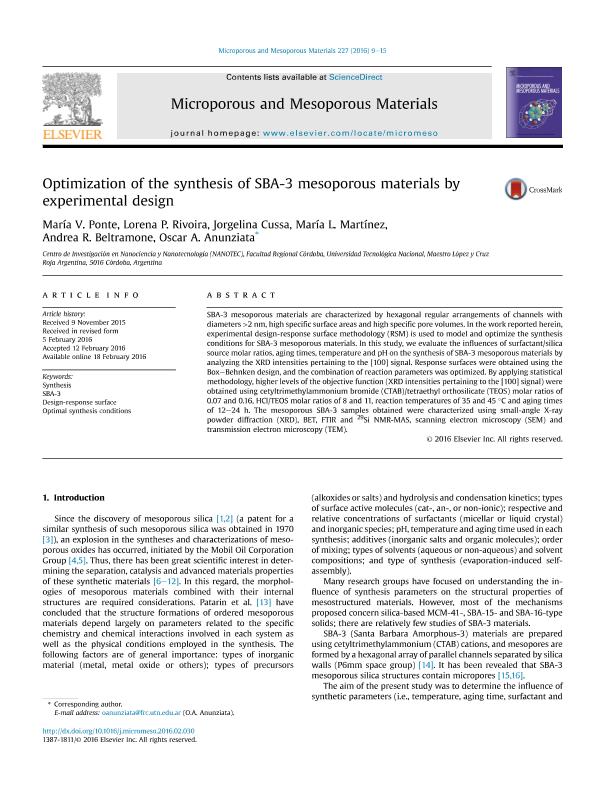Artículo
Optimization of the synthesis of SBA-3 mesoporous materials by experimental design
Ponte, María Virginia ; Rivoira, Lorena Paola
; Rivoira, Lorena Paola ; Cussa, Jorgelina
; Cussa, Jorgelina ; Martinez, Maria Laura
; Martinez, Maria Laura ; Beltramone, Andrea Raquel
; Beltramone, Andrea Raquel ; Anunziata, Oscar Alfredo
; Anunziata, Oscar Alfredo
 ; Rivoira, Lorena Paola
; Rivoira, Lorena Paola ; Cussa, Jorgelina
; Cussa, Jorgelina ; Martinez, Maria Laura
; Martinez, Maria Laura ; Beltramone, Andrea Raquel
; Beltramone, Andrea Raquel ; Anunziata, Oscar Alfredo
; Anunziata, Oscar Alfredo
Fecha de publicación:
02/2016
Editorial:
Elsevier Science
Revista:
Microporous and Mesoporous Materials
ISSN:
1387-1811
Idioma:
Inglés
Tipo de recurso:
Artículo publicado
Clasificación temática:
Resumen
SBA-3 mesoporous materials are characterized by hexagonal regular arrangements of channels with diameters >2 nm, high specific surface areas and high specific pore volumes. In the work reported herein, experimental design-response surface methodology (RSM) is used to model and optimize the synthesis conditions for SBA-3 mesoporous materials. In this study, we evaluate the influences of surfactant/silica source molar ratios, aging times, temperature and pH on the synthesis of SBA-3 mesoporous materials by analyzing the XRD intensities pertaining to the [100] signal. Response surfaces were obtained using theBoxeBehnken design, and the combination of reaction parameters was optimized. By applying statistical methodology, higher levels of the objective function (XRD intensities pertaining to the [100] signal) were obtained using cetyltrimethylammonium bromide (CTAB)/tetraethyl orthosilicate (TEOS) molar ratios of 0.07 and 0.16, HCl/TEOS molar ratios of 8 and 11, reaction temperatures of 35 and 45 C and aging times of 12e24 h. The mesoporous SBA-3 samples obtained were characterized using small-angle X-ray powder diffraction (XRD), BET, FTIR and 29Si NMR-MAS, scanning electron microscopy (SEM) andtransmission electron microscopy (TEM).
Palabras clave:
Synthesis
,
SBA-3
,
Design-response surface
,
Optimal synthesis conditions
Archivos asociados
Licencia
Identificadores
Colecciones
Articulos(CCT - CORDOBA)
Articulos de CTRO.CIENTIFICO TECNOL.CONICET - CORDOBA
Articulos de CTRO.CIENTIFICO TECNOL.CONICET - CORDOBA
Citación
Ponte, María Virginia; Rivoira, Lorena Paola; Cussa, Jorgelina; Martinez, Maria Laura; Beltramone, Andrea Raquel; et al.; Optimization of the synthesis of SBA-3 mesoporous materials by experimental design; Elsevier Science; Microporous and Mesoporous Materials; 227; 2-2016; 9-15
Compartir
Altmétricas



